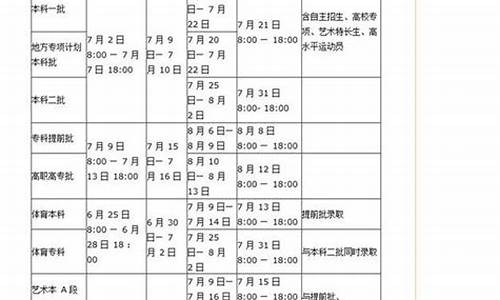您现在的位置是: 首页 > 教育资讯 教育资讯
2020年高考英语非谓语动词_2024高考非谓语
tamoadmin 2024-06-13 人已围观
简介1.非谓语的选择题怎么做?2.非谓语动词在高考中的占比3.高考英语非谓语动词巧记巧用4.探索被动语态的奥秘:谓语与非谓语的神奇之处5.高考英语语法辅导:非谓语动词做定语6.非谓语动词1. I send you 100 dollars today, the rest _____ in a year.A. follows B. followed C. to follow D.
1.非谓语的选择题怎么做?
2.非谓语动词在高考中的占比
3.高考英语非谓语动词巧记巧用
4.探索被动语态的奥秘:谓语与非谓语的神奇之处
5.高考英语语法辅导:非谓语动词做定语
6.非谓语动词

1. I send you 100 dollars today, the rest _____ in a year.
A. follows B. followed C. to follow D. being followed
剩余的将在一年还清,所以选C
2. _____from other continents for millions of years, Australia has many plants and
animals not found in any other country in the world.
A. Being separated B. Having separated
C. Having been separated D. To be separated
做原因状语,应为被隔离开很久,所以选C
1. The repairs cost a lot, but it’s money well_____.
A. to spend B. spent C. being spent D. spending
分析答案选B。因money与spend是被动关系,所以用过去分词。
2. The prize of the game show is$30000 and an all expenses _____ vacation to China.
A. paying B. paid C. to be paid D. being paid
分析答案选B。因all expenses与pay是被动关系,故用过去分词。注意句中的an 不是修饰 expenses,而是修饰vacation。
3. When _________help, one often says, “Thank you.” Or “It’s kind of you.” (福建卷)
A. offering B. to offer C. to be offered D. offered
分析答案选 D。因一个人说“谢谢”,应当是他被提供了帮助,所以要用过去分词,When offered help… =When he is offered help…
1. The storm left, _________a lot of damage to this area. (全国卷I)
A. caused B. to have caused C. to cause D. having caused
分析答案选D。因The storm与cause是主动关系,排除选项A;不定式作状语,前面通常不用逗号,排除B和C;因暴风雨给这个地区“造成损失”是在“结束”之前,所以用完成式。
2. More and more people are signing up for Yoga classes nowadays, _________ advantage of the health and relaxation benefits. (上海卷)
A. taking B. taken C. having taken D. having been taken
分析答案选 A。因people与take advantage of是主动关系,排除选项B和D;take不会发生在谓语are signing up之前,不用完成式,排除C。
1. “You can’t catch me!” Janet shouted, _________away. (全国卷III)
A. run B. running C. to run D. ran
分析答案选B。现在分词作伴随状语。
2. He glanced over at her, _________ that though she was tiny, she seemed very well put together. (广东卷)
A. noting B. noted C. to note D. having noted
分析答案选 A。因为he与note是主谓关系,且note与谓语动词glanced的动作同时发生,所以用现在分词的一般式作伴随状语。
3. Daddy didn’t mind what we were doing, as long as we were together, _________fun. (重庆卷)
A. had B. have C. to have D. having
分析答案选 D。用现在分词表伴随情况。
说明:有时过去分词也可表伴随(注意过去分词同时还表被动关系),但高考很少考查此用法。如:
He came in, followed by his wife. 他走了进来,后面跟着他的妻子。
在通常情况下,用作目的状语只能是不定式。如:
1. “Can the project be finished as planned?” “Sure, _________it completed in time, we’ll work two more hours a day.” (福建卷)
A. having got B. to get C. getting D. get
分析答案选 B。作目的状语只能用动词不定式。
2. _________ more about university courses, call (920) 746-3789. (浙江卷)
A. To find out B. Finding out C. Find out D. Having found out
分析答案选 A。作目的状语要用动词不定式。
3. It was unbelievable that the fans waited outside the gym for three hours just _________a look at the sports stars. (上海卷)
A. had B. having C. to have D. have
分析答案选 C。“看看体育明星”是“在体育馆外等三个小时”的目的,作目的状语只能用动词不定式。
1. 用现在分词表结果。如:
He fired, killing one of the passers-by. 他开枪了,打死了一个过路人。
Oil prices have risen by 32 percent since the start of the year, _________a record US $ 57.65 a barrel on April 4. (山东卷)
A. have reached B. reaching C. to reach D. to be reaching
分析答案选B。伴随着谓语动词的发生而产生的自然结果,用现在分词作结果状语。
2. 用不定式表结果。如:
He returned home to find his wife waiting for him. 他回到家发现他的妻子在等他。
He hurried to the station only _________ that the train had left. (广东卷)
A. to find B. finding C. found D. to have found
分析答案选 A。因为only to do是习语,意为“结果却,不料”,hurried和find是先后发生的两个动作。
非谓语的选择题怎么做?
考察非谓语动词的话,若是非谓语作状语,则一般空是在一个完整的句子外;非谓语作定语相对较简单就不用说了。
考查动词的时态和语态,空通常是在句中。
另外你没说是选择题还是完型,或是阅读。
非谓语动词在高考中的占比
高考关于非谓语动词的考察一般比较侧重在对分词和不定式做定语和状语这方面上。我在此建议你这么做:
1、准确划分好题干的句子结构,找到句子的主语、谓语和宾语,正确理解句子的意思。这样就已经成功了大部分了。
2、如果你在to do、doing和done之间犹豫的话,就要特别注意时态。要弄清楚题目中描述的东西是已经做了的、正在做着的还是将来准备要做的。
3、如果是在doing和done,或者是to do和to be done之间选择的话,就要弄清句子中主动和被动的关系。主动的用doing或to do,被动就用done或者含有done的相符合的形式。
4、碰到having been done和done这样的选择时,就要注意好两个动作是同时发生的,还是一先一后的。如果是一先一后就用有have的形式,反之就不用。
总之,现在刚刚学了这个内容,不妨在理解了上面的内容以后先耐心的做做相关的题目。你会发现很多题目考来考去都是一样的内容。到了高三复习以后还会有不少的题目可供发掘,静下心慢慢学,真的不难的~
是否可以解决您的问题?
高考英语非谓语动词巧记巧用
占比重。非谓语动词在高考中所占比重,在高考试卷中依然占据着不可替代的位置,非谓语动词,又叫非限定动词,非谓语动词是指在句子中不是谓语的动词,主要包括不定式、动名词和分词(现在分词和过去分词),即动词的非谓语形式。
探索被动语态的奥秘:谓语与非谓语的神奇之处
高考英语非谓语动词巧记巧用
一、接不定式和接动名词意义不同的动词和短语
在下列8个动词和短语动词后接不定式和接动名词意义不同:
remember to do(记住去做) remember doing(记得做过)
forget to do(忘记去做) forget doing(忘记做过)
regret to do (遗憾地做) regret doing(后悔做了)
try to do(设法做) try doing(试做)
go on to do(接着做另一事) go on doing(继续做同一事)
mean to do(打算做) mean doing(意味着)
stop to do(停下来去做) stop doing(停止做)
can’t help to do(不能帮助做) can’t help doing(情不自禁做)
1. —You were brave enough to raise objection at the meeting.
—Well, now I regret ________ that. (全国卷)
A. to do B. to be doing
C. to have done D. having done
分析答案选D。由语境可知“我”“后悔”在会上提出异议,应接动名词。
2. —The light in the office is still on.
—Oh,I forgot ________. (全国卷)
A. turning it off B. turn it off
C. to turn it off D. having turned it off
分析答案选C。表示忘记做某事,事情还没做,forget后接不定式。
3. In some parts of London, missing a bus means ________ for another hour. (上海卷)
A. waiting B. to wait
C. wait D. to be waiting
分析答案选A。由语境可知句中的mean表示“意味着”,后接不定式。
4. She reached the top of the hill and stopped ________ on a big rock by the side of the path. (全国卷)
A. to have rested B. resting
C. to rest D. rest
分析答案选C。休息是停下来的目的,且发生在stop之后,用接不定式的一般式。
5. Go on ________ the other exercise after you have finished this one. (全国卷)
A. to do B. doing
C. with D. to be doing
分析答案选A。表示做完一事后“接着做”另一事,go on后接不定式。
二、表示未成实现的愿望或打算的动词和短语
表示未曾实现的愿望或打算,即表示“本打算 / 想 / 希望做某事”但事实上却没做的事情,用plan, intend, mean; want, hope, wish, expect等动词的过去完成时,加不定式的一般式,或者这类动词的一般过去时,加不定式的完成式;was / were, would / should like加不定式的完成式;was / were going加不定式的一般式。如:
I would love ________ to the party last night but I had to work extra hours to finish a report. (全国卷)
A. to go B. to have gone
C. going D. having gone
分析答案选B。由句意可知,是表示过去未曾实现的期望,用“would love+不定式完成式”。句意是:昨晚我本想去参加聚会的,但是…(from www.nmet168.com)
三、要接动名词的含有介词的常用句型
在介词后一般用动名词,下面是一些含介词的固定句式(其中有的介词有时会被省略):prevent / stop / keep sb. / sth. from doing (阻止…做…);spend / waste time or money in doing (在做…方面花费 / 浪费时间或金钱);How / What about doing sth. (做…怎么样?);have some difficulty / trouble in doing (在做…方面有些困难);have a hard time in doing sth. (做某事很艰难); there is no sense in doing(做…是没有理由 / 道理的);thank (excuse / admire / praise / blame / scold / punish) sb. for doing sth. (因做某事而感谢 / 羡慕 / 表扬 / 责备某人)等。如:
1. Having been ill in bed for nearly a month, he had a hard time ________ the exam. (福建卷)
A. pass B. to pass
C. passed D. passing
分析答案选D。因为have a hard time (in) doing sth. 在做某事方面有困难。
2. According to a recent U. S. survey, children spend up to 25 hours a week ________ TV. (上海卷)
A. to watch B. to watching
C. watching D. watch
分析答案选C。spend some time (in) doing sth. 做某事花了多长时间。
3. I believe that’s the best way to prevent such a thing ________ again. (全国卷)
A. to happen B. from happening
C. happened D. happen
分析答案选B。prevent sb. / sth. from doing 阻止…做…。
4. Did you have trouble ________ the post office? (全国卷)
A. to have found B. with finding
C. to find D. in finding
分析答案选D。have difficulty / trouble (in) doing sth. 在做方面有困难。
四、to是介词的常用固定结构
to是介词和固定词组很多,常见的有:look forward to(盼望), devote…to / be devoted to(致力于), be / get used to(习惯), lead to(导致), get down to(开始认真), pay attention to(注意), refer to(谈到), point to(指向), turn to(转向), object to(反对), equal to(等于、能胜任), belong to(属于)等。如:
1. Mr. Reed made up his mind to devote all he had to ________ some schools for poor children. (上海卷)
A. set up B. setting up
C. have set up D. having set up
分析答案选B。devote…to…中to是介词,接动名词;all是devote的宾语,he had是省略了关系代词that的定语从句。
2. The discovery of new evidence led to ________. (上海卷)
A. the thief having caught B. catch the thief
C. the thief being caught D. the thief to be caught
分析答案选C。lead to中的to是介词,后接动名词;逻辑主语the thief与catch是被动关系,所以用动名词的被动式(from www.nmet168.com)。
3. She looks forward every spring to ________ the flower-lined garden. (上海卷)
A. visit B. paying a visit
C. walk in D. walking in
分析答案选D。look forward to中to是介词,后接动名词。再说,若visit用作名词,后面要加介词to,才可接宾语,排除A和B;walk作名词,表示散步,仅用于go for / take / have a walk等结构,排除C。
高考英语语法辅导:非谓语动词做定语
被动语态是英语语法中的一个重要概念,也是许多学习者的难点。我们将深入探索谓语与非谓语的被动语态,让你们在掌握知识的同时,享受语言的美妙。
谓语的被动语态谓语的被动语态有多种时态变化,包括现在进行时的被动语态、过去完成时的被动语态、含情态动词的被动语态等。这些时态变化的规律,让我们更好地理解被动语态的应用。
非谓语的被动语态非谓语的被动语态同样精彩纷呈,包括不定式的被动语态和doing的被动语态。这些语态的应用,让我们更好地理解被动语态的语法结构。
学习笔记分享本文分享了被动语态的谓语和非谓语的应用,希望能够帮助大家更好地掌握这一语法知识。如果你觉得这些内容对你有所帮助,别忘了分享给你的朋友们哦!
非谓语动词
南开中学 李士明
非谓语动词做定语
直接修饰名词的成分称为定语,一般由形容词或名词担当,也可以分别由不定式、分词或动名词等非谓语动词来担当。那么如何区别并正确使用非谓语动词呢?
NON-FINITES
1. 现在分词与过去分词的区别
我们知道非谓语动词都源于及物和不及物两种谓语动词,要了解现在分词与过去分词的区别就要从谓语动词的基本属性开始。
1)及物动词 (v.t.)
及物动词的主语我们称为动作的发出者(sender),宾语称为动作的承受者(receiver)。
例如:
The news surprised
动词+ing (发出者) 及物动词v.t.
the students.
动词+ed (承受者)
Surprise是及物动词, 在使用surprise这个动词的非谓语分词形式时,修饰动作发出者news用现在分词形式(动词+ing),修饰动作的承受者用过去分词形式(动词+ed)。
●They are talking about the surprising news. (surprising做定语修饰发出者news)
The news is surprising. (surprising做表语修饰发出者news)
They are talking about the surprised students. (surprised做定语修饰承受者students)
The students are surprised. (surprised做表语修饰承受者students)
再来看几个例子:
●exciting games激烈精彩的比赛, excited spectators激情振奋的观众
●disappointing results令人沮丧的结果, disappointed people大失所望的人们
●exhausting work令人疲惫不堪的工作, exhausted workers筋疲力尽的工人
●moving stories感人肺腑的故事, moved students感激涕零的学生
从以上例子可见,现在分词和过去分词都可以用作形容词来修饰名词,修饰动作发出者用现在分词,修饰动作承受者用过去分词。要特别注意的是,依据被修饰的名词是人还是物来判断现在分词和过去分词的用法是不准确的。
例如: They complicated the situation by introducing some more restriction.
他们采用了一些更多的限制把形势复杂化了。
及物动词complicate的发出者是人they, 而承受者是物。因此,“复杂恶化的形势”应译为the complicated situation,“形势是令人棘手的” 应译为The situation is complicated.
从这个例子可以清楚地看出,如果根据中文,很容易将“令人棘手的形势”错误地理解为 “complicating situation”。
再比如我们常用的:
a broken cup 一个破杯子; spoken English英语口语;exported products出口产品。
因此,准确了解所修饰的名词与及物动词的关系,是正确使用及物动词的现在分词和过去分词的关键。
2) 不及物动词(v.i.)
不及物动词只有动作的发出者,不存在动作的承受者。因此,不及物动词的现在分词源于进行时,表示动作正在进行,而过去分词则源于完成时,表示动作已完成。
例如:
●He looked at the leaves which are falling in the air.(从句用进行时修饰名词the leaves)
他看着空气中飘然下落的叶子。
=He looked at the leaves falling in the air.(现在分词短语修饰名词the leaves表示进行)
=He looked at the falling leaves in the air. (现在分词修饰名词the leaves表示进行)
●He walked on the leaves which had fallen on the ground.(从句用完成时修饰名词the leaves) 他走在地面的落叶上。
He walked on the leaves fallen on the ground.(过去分词短语修饰名词leaves表示过去)
He walked on the fallen leaves on the ground. (过去分词修饰名词leaves表示过去)
●the rising sun. = the sun that is rising. 冉冉升起的太阳
the risen sun = the sun that has risen. 已经升在天空的太阳
●boiling water = water which is boiling. 沸腾的水
boiled water = water which has boiled 开过的水
2. 不同形式不定式做定语的区别
动词不定式的一般式可以用做形容词,担当名词的定语, 表示将要发生的动作,不定式的进行式和完成式都不可以用作定语。
1)及物动词不定式一般式主动to do sth和被动to be done 两种形式的区别。
例如:
●Have you anything to send? = Have you anything that you will send?
你有什么东西要(自己)寄吗?(主动含义,动作由you自己去完成)
(to send做定语, 源于定语从句that you will send, 修饰先行词anything, 表示将来。)
●Have you anything to be sent (by others)?=Have you anything that will be sent(by others)?
你有什么东西要(我或别人)寄吗?(被动含义,动作由他人others去完成)
(to be sent做定语, 源于定语从句that will be sent, 修饰先行词anything, 表示将来。)
从以上两个例子可以看出,不定式的主动形式to send来源于主动语态的定语从句。
而不定式的被动形式to be sent来源于被动语态的定语从句, 不能错误地认为to send 是主动形式表示被动,准确地讲应该牢记主动形式的不定式源于主动语态的从句,被动形式的不定式则源于被动语态的从句,两者绝不可以混淆。
●I have some books for you to read. = I have some books that you should read.
我有几本书希望你读一读。
(for you to read做定语, 源于定语从句that you should read, 修饰先行词books, 表示将来。原从句的主语you在不定式的前面以for you 的形式出现,担当不定式的逻辑主语。)
2)不及物动词不定式一般式做定语
当不及物动词做定语时, 后面必须有相应的介词与前面所修饰的名词相呼应, 从汉语角度理解,而忽略了必要的介词是不及物动词做定语时常见的错误。
例如:
●He is looking for a room to live in.= He is looking for a room which he will live in.
他现在正在找房间住。
(to live in做定语, 源于定语从句which he will live in, 修饰先行词room, 表示将来。)
●Would you like to have another pen to write with? ( to write with the pen)
你需要再准备一支笔用吗?
●Smith is a good man to work with. ( to work with the man)
与史密斯一起工作是再好不过了。
●Lei Feng is a brilliant example for us to learn from. ( to learn from the example)
雷锋是我们学习的光辉榜样。
●Can you lend me a chair to sit on?
您可以借给我一把椅子坐吗?
●Global Financial Crisis is a hot topic to talk about today. ( to talk about the topic)
全球性金融危机是当前人们谈论的热点话题。
高考英语语法专题讲解-主谓一致
★着重讲解混搭情况,均遵守以下原则:
1. 意义一致原则
主语后跟有以下引起的短语:谓语动词仍与短语前的主语的形式保持一致。
1.1 (together) with: Alice (together) with her parents often goes to the park on Sundays.
1.2 except/but: Every picture except/ but these two has been sold.
Nobody but Mary and I was in the classroom at that time.
1.3 no less than: His sister, no less than you, is wrong.
1.4 rather than: The father, rather than the brothers, is responsible for the accident.
1.5 perhaps : Peter, perhaps John, is playing with the little dog.
1.6 like: He, like you and Xiao Liu is very diligent.
1.7 including/ besides/ as well as
2. 就近原则
2.1 主语由以下连词连接:谓语动词与后一个主语一致:
2.2.1(Either)…or…: Either you or I am going to the movies.
2.2.2 Neither…nor…
2.2.3 Whether…or…
2.2.4 Not only…but (also)
2.2.5 Not…but…
2.2 there be 句型: be 动词与后面第一个名词一致
E.g. There is an apple, two bananas and some oranges on the plates.
2.3副词here, there, now, then, up, down, in, out, away, such连接的全部倒装结构中:谓语动词由动词后面的主语决定
On the wall hang two maps. 墙上挂着两张地图。
On the wall hangs a world of map. 墙上挂着一张世界地图。
Such is the result. 结果就是这样。
Such are the results. 这就是结果
3. 整体原则
3.1 并列主语如果指的是同一个人、同一事物或同一概念时,谓语动词用单数,and后面的名词没有冠词:
The writer and worker is coming to our school tomorrow.
(一个人)
The writer and the worker are coming to our school tomorrow.
(两个人)
Bread and butter is their daily food.
3.2表示时间、距离、价格、度量衡等的复数名词或短语作为一个整体看待时,谓语动词常用单数形式:
E.g. Three years is not a long time.
Ten dollars is what he needs.
Five hundred miles is a long distance.
3.3复数形式的专有名词作为整体看待(人名、地点、国家、组织、书籍、报刊等),动词用单数形式:
E.g. The United Nations has passed a resolution(决议)。
“The Arabian Nights”(《天方夜谭》)is an interesting book.
3.4集合名词people, police ,cattle作主语,谓语动词用复数形式:
E.g. The police are searching for him.
The cattle are grassing (吃草)。
4. 谓单原则
4.1 and连接的并列单数名词前如有each, every, no修饰时,谓语动词要用单数形式。
E.g. Every boy and girl has been invited to the party.
No teacher and no student is absent today.
Many a student is busy with their lessons.
4.2 用many a, more than one 修饰名词时,谓语动词要用单数形式。
E.g. More than one person has made the suggestion.
Many a rough man has been civilized by his wife.
4.3 Each, Either, One, Another, The other, Neither作主语时,谓语动词用单数形式:
E.g. Each takes a cup of tea.
Either is correct.
4.4 由every, some, any, no构成的合成代词作主语时,谓语动词用单数形式:
E.g. Nothing is to be done.
4.5 means, politics, physics, plastics作主语时,谓语动词用单数形式.
5. 具体情况原则
5.1 all, few, more, most, some, any, none, half, the rest等作主语时,既可表示复数意义,也可表示单数意义,谓语动词要根据实际情况而定:
All of the apple is rotten. 整个苹果都烂了。
不可数-> 谓单
All of the apples are rotten. 所有的苹果都烂了。
可数-> 谓复
Most of the wood was used to make furniture.
不可数-> 谓单
Most of the people are from England.
可数-> 谓复
5.2 the + 形容词(或分词)作主语时,常指一类人,谓语动词用复数形式。如指的是抽象概念,谓语动词则用单数形式:
5.3 population当人口讲时,谓语动词用单数形式;当人们讲时,谓语动词用复数:
5.4 the number of + 名词复数,是表示“…的数字”,作主语时,谓语动词用单数形式;
a (large / great) number of + 名词复数,表示许多,作主语时;谓语动词用复数形式:
5.5 有些集体名词如family, team, group, class, audience, 等作主语时,如看作是一个整体,谓语动词则用单数形式;如强调各个成员时,谓语动词要用复数形式:
6. 先行词原则
关系代词who, that, which等在定语从句中作主语时,其谓语动词的数应与句中先行词的数一致。









